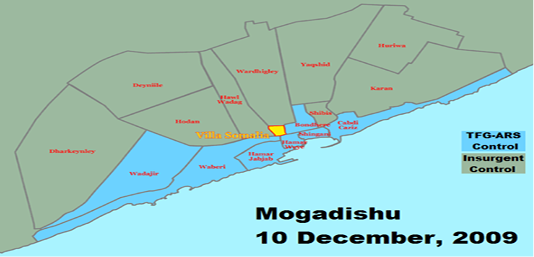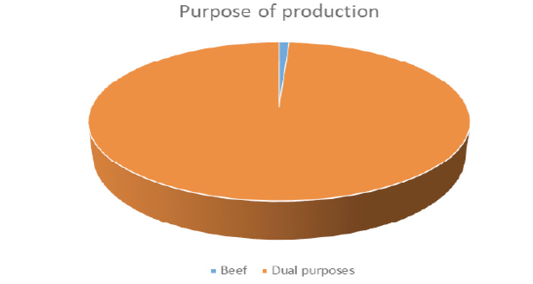Advances in Animal and Veterinary Sciences
Research Article
Assessment of Reproductive Efficiency and Herd Dynamics of Local Cattle Breeds in Benadir Region, Somalia
Hassan Mohamed Hassan1, Abdirahman Bare Dubad2*, Muscub Mohamed Muse3, Abdulkadir Mumin Ali3, Burhan Said Ali3
1Faculty of Veterinary Medicine and Animal Husbandry, Somali National University, Somalia; 2Faculty of Veterinary Medicine and Animal Husbandry, Somali National University, Somalia; 3Faculty of Veterinary Medicine and Animal Husbandry, Somali National University, Somalia.
Abstract | Reproductive performance is one of the most important economic traits in beef or dairy production. The majority (60%) of Somalis are pastoral nomads and engage livestock production for livelihood, employment and income. Recurrent droughts and diseases are discouraging the pastoral production systems and forcing some pastoralists and diaspora to adopt small scale dairy production. Measuring the reproductive efficiency of dairy production in Somalia is paramount and deemed necessary. Therefore, an assessment was launched to assess factors that affect reproductive performance and understand the breeding regularity of local cattle breeds in Benadir region. This study was cross sectional and took place from Feb. 2018 to Feb. 2019. The study used both qualitative and quantitative data collection methods. A total of 100 respondents were interviewed to collect qualitative data while a total of 2916 cattle were examined to gather quantitative data. The overall estimated means for age at puberty (AP), age at first calving (AFC) and calving interval (CI) was: 37.9 months, 49.2 months, and 19.15 months respectively. The percentage of cows weaned live calf was 57.6%. The average milk yield of local breeds is estimated to be 8 liters per day with average lactation period of 7.7 months. In calves, the average birth weight, weaning weight, maturity weight was 15.22 kg, 156.3 kg, and 310.28 kg respectively. The fertility rate was also measured and it was found that the average conception rate to be 18%, a general fertility of 53.85% , a dystocia rate of 5.6%. Heredity, nutritional stress and diseases appeared to be the main problems causing low reproductive efficiency in the study area. Other challenges in cattle production in the area were low inputs and poor facilities. Therefore, it is recommendable that short trainings and appropriate technology transfer in delivering animal husbandry practice and basic veterinary services to small holder farmers in Benadir region.
Keywords | Dairy, Maturity, Fertility, Herd composition, Wieght
Received | March 26, 2020; Accepted | July 15, 2020; Published | August 10, 2020
*Correspondence | Abdirahman Bare Dubad, Faculty of Veterinary Medicine and Animal Husbandry, Somali National University, Somalia; Email: [email protected]
Citation | Hassan HM, Dubad AB, Muse MM, Ali AM, Ali BS (2020). Assessment of reproductive efficiency and herd dynamics of local cattle breeds in Benadir Region, Somalia. Adv. Anim. Vet. Sci. 8(10): 1100-1108.
DOI | http://dx.doi.org/10.17582/journal.aavs/2020/8.10.1100.1108
ISSN (Online) | 2307-8316; ISSN (Print) | 2309-3331
Copyright © 2020 Hassan et al. This is an open access article distributed under the Creative Commons Attribution License, which permits unrestricted use, distribution, and reproduction in any medium, provided the original work is properly cited.
INTRODUCTION
More than 60% of the Somali populations in the federal republic of Somalia are nomads and engage livestock production for their livelihoods, employment and income. Pastoral communities are low income societies who mainly depend on subsistence livestock production and are economically marginalized while Livestock sector contributes 80% of export earnings and more than 40% of the GDP of the country (Hasaan MH and Adan JA, 2001).
Livestock is the backbone of Somalia’s economy (MLFR, 1981). In 1989 estimates of the livestock resources of Somalia were 20 Million of Goats, 14 Million of Sheep, Seven Million of Camels and Five Million of Cattle . Mogadishu as the capital city of Somalia has attracted small scale dairy farmers due to the demand for dairy products due to the population increases. (MLFR, 1981).
Owing to the climatic characteristics of Somalia, Cattle are the most vulnerable species of farm animals reared in Somalia. The stifling challenges of cattle rearing is due to seasonal shortage of water and pasture resulting from recurrent and prolonged droughts, range degradation, lack of established animal feed industries in Somalia. Unlike camel that strive in the arid and semi-arid areas; cattle herds may not be able travel long distance for the search of good quality pasture and water forcing cattle herders stay adjacent to permanent water points during dry seasons and droughts where land degradations are evident (FAO and World Bank, 2004). With these challenges in mind the cattle production is increasing in Benaadir region, where diaspora and business men are investing heavily in the sector. The new dairy farms are mainly using both exotic and indigenous breeds although most farmers keep indigenous breeds for meat and milk. And this paper will focus and measure the productivity of the indigenous cattle and asses’ factors that affect productivity and efficiency of local cattle breeds in the area.
MATERIALS AND METHODS
Study area
Benadir is an administrative region in south-eastern Somalia, Banadir is interwoven with capital city of Mogadishu, Somalia’s capital is the smallest administrative region when compared to states. Benadir’s population is estimated 3 million and it consist of seventeen districts. Benadir region and the it is surrounding is known as the dairy corridor of Somalia. As it harbored the breeding center of Somalia before the collapse of the former regimes.
Benadir map
Study design
This study was cross sectional and took place from Feb. 2018 to Feb. 2019. There was one principle researcher and four research assistants who mainly collected data from the small scale dairy farmers in Banadir region of Somalia. The study used both qualitative and quantitative data and 100 respondents were interviewed. The 100 respondents interviewed had A total number of 2916 cattle that were examined for their body weights, herd composition, fertility, conception rate.
Study population
Cattle herds in Benadir region of somalia were the target population of this study. A sample of 100 farmers were administered to questionnaires. And a total of 2916 cattle were also studied to collect quantitative data like weights.
Sample size
The Slovan’s statistical formula was used to calculate the desired sample size as follows:
N=134, e= 5%, 0.05, n=?
Solution
n= N/ (1+ (N*e^2)); n= 134/ (1+ (134*0.05^2)); n= 134/ (1+ (134*0.0025)); n=134/ (1+ (0.335)); n=134/1.335; n=100.
Sampling procedure
In this study, villages were selected purposively. The selections of the villages were based on the resident’s background of livestock keeping therefore those villages that had substantial number of livestock keepers were selected. The respondents were selected randomly from the selected villages, with help of village administrator’s small holder dairy farmers list were used to retrieve names of dairy farmers and their location and they were then but into a bowl and randomly picked 100 respondents.
Data collection tool
The researchers collected primary data using questionnaires; the selection of this instrument is guided by the time available to conduct this research, research questions and objectives of this study.
The researchers used weight band and scale to collect qualitative data such as the weight of animal, the weaning weight. However, data such as the birth weight was based on respondents records, recall and memory.
Data analysis and management
The data was collected and systematically organized in a manner that facilitated to present the data, so the researchers used quantitative data analysis in this study. To analyze the data, the researchers used descriptive statistics to describe the variables in this study. The data collected was organized, summarized, statistically treated and drafted in Statistical Package for Social Sciences (SPSS 23rd version). The researchers analyzed the data using descriptive statistical techniques.
RESULTS AND DISCUSSION
Introduction
General information about the respondents
A total of 100 respondents dully filled in the questionnaires, using experienced cattleman owned herds in Benadir, Somalia. Gender
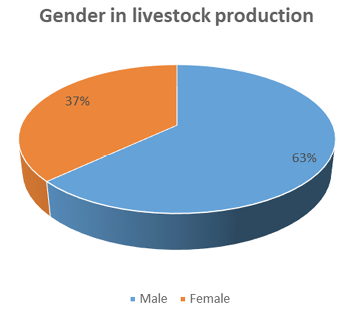
Figure 1: Gender in small livestock production.
Data in Figure 1 shows that 63% of the respondents of this study were male while 37% of the respondents were female. Based on data gathered, the majority of the respondents of this study were male.
Type of livestock production systems
In Figure 2 the data indicates that most of the respondents (75%) practiced semi- intensive while 25% of the respondents practiced extensive production system. Generally, majority of livestock keepers in Banadir region uses Sem-intensive production system in which they release their cattle earlier in the morning to scavenge in the city.

Figure 2: Livestock production systems.
Purpose of production
The data in Table 1 indicates that, most of the respondents (99%), in this study reared cattle for milk production while (1% reared cattle for beef). The main purpose of keeping livestock in urban and peri-urban areas is for milk production and this is similar to study made in Burkino faso that reported the main purpose for livestock keeping is for milk. The traditional system in Benaadir areas, where lactating animal is brought to the urban-peri urban areas to milk them and sent back into extensive pastoral systems. unlike system of production in Burkinofaso, where modern production keeps animal in the urban and peri-uban regardless of it is production status. (Hamadou and Sanon, 2006; Kamuanga et al., 2008; Francis and Tylor, 2013).
| Type of feed used | Percentage of respondents |
| Straw and concentrate | 67 |
| Concentrate feed | 12 |
| Grass | 15 |
| All | 6 |
Breed type
As shown in Figure 3, majority of the respondents reared local breeds (99%), except one responder who had mixed breeds (1%). These shows that small scale dairy farmers in Banadir region stock local breeds for dairy.
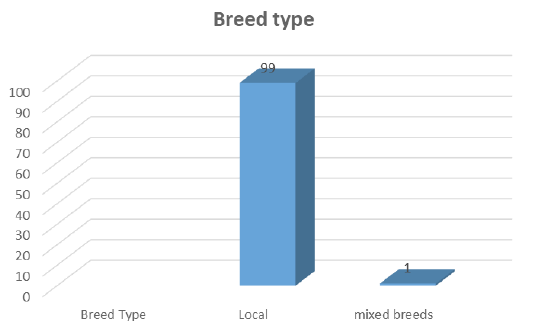
Figure 3: Breed type.
Type of roughage used for dry season
In Table 1 shows that most of the respondents (67%) used roughage as straw and concentrate together and 12% used only concentrate as animal feeds. While those who used grass for feeding were (15%) and those used combinations of all ingredients were (6%).
Heat detection use and breeding technique
The result in Figure 4 shows that most of respondent used expert eyes or observations to detect heat were (85%) and second largest respondent (11%) used teaser bulls, while (4%) don’t bother detecting heat were.
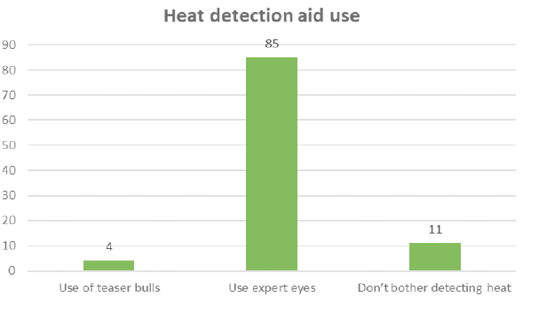
Figure 4: Use of heat detection aids.
While the breeding technique of majority of respondent (98%) were natural mating (bulls) in their breeding. Those using artificial insemination (AI) were too low (2%).
Challenges
In Table 2 shows that 35% of the respondents indicated that diseases were the major challenges in small scale production in Banadir region, it is followed by nutrition and shortages of feed in which 33% of the respondent noted as major constraints in small scale production in Banadir region. Heredity (14%) and poor facility (4%) were also mentioned as the challenges in dairy production in the study area. However, 10% of the respondents noted that all the challenges in the table were all contributing the challenges in diary production,
Table 2: Challenges faced by small scale diary producers in Banadir region.
| Challenges | Percentage of respondents |
| Disease | 35 |
| Water and food shortage/low input | 33 |
| Heredity/breed | 14 |
| Poor facilities | 8 |
| All | 10 |
Herd size and herd composition
The data in Table 3 above shows the herd composition of the farms surveyed, 43.2% are cows, 21.09% heifers, 23% calves and 12.54% bulls and 0.2% steers.
Reproductive parameters
In Table 4 above shows shows that the average mean of age at puberty in this study was 37.9 month, the age at first calving from the data gathered in Table 4 also illustrates that the mean age at first calving was 49.32. This study also reveals the mean of calving interval and days open of local breeds in Benadir to be 19.15 months and 98.8 days respectively.
Table 3: Herd size and herd composition.
| Herd composition | Total | Mean | Percentage |
| Cows | 1262 | 12.62 | 43.2% |
| Heifers | 615 | 6.15 | 21.1% |
| Calves | 672 | 6.72 | 23% |
| Bulls | 366 | 3.66 | 12.5% |
| Steers | 7 | 0.07 | 0.2% |
| Total herd | 2916 | 29.16 |
Table 4: Reproductive parameters.
| Parameter | Mean |
| Age at puberty (month) | 37.9 |
| Age at first calving(month) | 49.32 |
| Calving interval(month) | 19.15 |
| Days open(days) | 98.4 |
| Milk yield (litters) | 8 |
| Lactation length(months) | 7.7 |
| Birth weight(kg) | 15.22 |
| Weaning weight(kg) | 156.3 |
| Mature weight(kg) | 310.28 |
| Conception rate | 1.8 |
| General fertility (%) | 53.85 |
| Average of cow weaned life calf (%) | 57.6 |
| Dystocia rate (%) | 5.6 |
| Body condition score | 3.25 |
The data in Table 4 gain shows that the averages mean of milk production and lactation length of the local cattle breeds to be 8 litters and 7.7 month of lactating period.
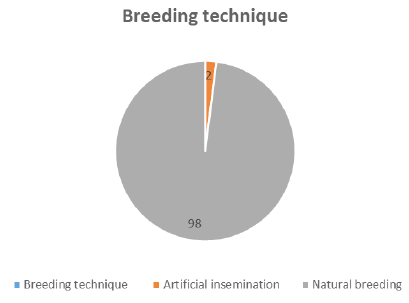
Figure 5: Breeding technique.
As the result in Table 4 shows, the average general fertility and conception rate were 53.85 and 1.8 respectively. It is also evident that the mean birth weight, weaning weight and mature weight was found to be 15.22, 156.3 and 310.28 kg respectively. The result in Table 4 shows that the average percentage and mean of cows weaned life calf in were 57.6%, The average percentage of dystocia showed in this study was 5.6%.
Discussion
Dairy production in Somalia is at it is juvenile stage and has not been utilized properly. It is similar to developing countries where dairy producers struggle to achieve peak production. Dairy farming is mainly practiced around Banadir region due to the high demand for milk in the capital city of Somalia Mogadishu. Therefore, this study assess reproductive efficiency and herd dynamics of local cattle breeds in benadir region, Somalia.
In this study 63% of the respondents of this study were male while 37% of the respondents were female. The gender parity in livestock production exists in all African countries, and it is an indication that livestock production and ownership is dominated by men. A similar report was made by (Esenu, 2005), in Uganda who reported 76% of the livestock owners interviewed were male while 34 were women. Essenu further reported that male child involved livestock production more than the girl child and this is a way of grooming the male child to inherit livestock and land and this resonates what really exists in Somalia. The same has been reported from Zambia that men eclipse women on the ownership of valuable livestock and bars women from benefiting and decision making (Mupawaenda et al., 2009).
In this study it is indicated that most of the respondents (75%) practiced semi- intensive while 25% of the respondents practiced extensive production system. Generally, livestock keepers in urban areas adopt intensive farming due to poor land security and feed resources. This rhyme with what was found in Burkino faso by (Regina et al., 2016), who reported that livestock in urban and peri-urban are intensive and the purpose of keeping is mainly for dairy. (Francis and Tylor, 2013), also reported that livestock production in urban and peri-urban areas is costly and needs high input in feeding, housing and health care. This is true in the vicinity of Benaadir and livestock keepers evade the high cost of input by adopting semi-intensive livestock keeping where cattle and goats are released to scavenge discarded food products in town.
Majority of the respondents of this study reared local breeds (99%), except one responder who had mixed breeds (1%). This is similar to what was reported by: (Regina et al., 2016) in that the major breeds kept in urban and peri urban areas of Augodugu is the local breeds (Zebu) and still practice transhumance production. And the producers are deemed to be the original livestock keepers who moved to the urban centers. The small scale dairy farmers who keep indigenous breed have poor productivity that is associated to the poor breed, poor housing and management systems (Hamadou and Sanon, 2006; Ndambi et al., 2008).
The study also shows that most of the respondents (67%) used roughage as straw and concentrate together and 12% used only concentrate as animal feeds. While those who used grass for feeding were (15%) and those used combinations of all ingredients were (6%). This is close to what was reported by (Chalchissa et al., 2014) that livestock fed in urban and peri-urban areas mainly comprises of wheat straw and Tef, (Chalchissa et al., 2014). A similar study reported that farmers resort to crop residue as animal feed due to shortage of land space, climate change, and rangeland degradation. This omitted the option of producing and feeding with good quality of hay.
The result in this study shows that most of respondent used expert eyes or observations to detect heat were (85%) and second largest respondent (11%) used teaser bulls, while (4%) don’t bother detecting heat were. As the study suggests the heat detection techniques is unsatisfactory and this is similar to other study that reported the heat detection tool used was mainly visual which is unsatisfactory (Belihu, 2002), as another study also reported that animals to be anestrus proofed to cycling normally with use of progesterone test (Alemselam, 2016). Therefore, poor estrus detection technique contributes to the poor productivity of cattle farmers in Benadir region, While the breeding technique use by the majority of respondent (98%) were natural mating (bulls) in their breeding. Those using artificial insemination (AI) were too low (2%). This is contrary to a study conducted in Ethiopia which reported breeding techniques practiced as follows: Natural mating 26%, AI 34% and mixed 39%. The reason why natural mating is still high is due to lack of AI technicians, poor conception rate due to improper semen handling, breeding dalliance and poor animal nutrition, poor body condition, carelessness, reproductive health problems (Alemselam, 2016).
As per the study, 35% of the respondents indicated that diseases were the major challenges in small scale production in Banadir region, it is followed by nutrition and shortages of feed in which 33% of the respondent noted as major constraints in small scale production in Banadir region. Heredity (14%) and poor facility (4%) were also mentioned as the challenges in dairy production in the study area. However, 10% of the respondents noted that all the challenges in the table were all contributing the challenges in diary production, nutritional stress and diseases appeared to be the main problems causing low reproductive in efficiency in the study area. Other challenges in cattle production in the area were low inputs and poor facilities . This is close to what reported from somali region of ethioipia, the report indicates that The major challenges faced by dairy farmers was feeding shortage (23.1%), water scarcity (15.4%), drought 11.54% and disease 10% (Zewdie, 2016). Another research conducted in Kenya reported that diseases, inadequate feed resources, high prices of animal feeds, low fertility and poor infrastructure are the major challenges in small scale dairy producers in nairobi county (Milcah, 2018).
The herd composition of the farms surveyed, were 43.2% are cows, 21.09% heifers, 23% calves and 12.54% bulls and 0.2% steers. This is close to what was reported from study conducted in western kenya dairy farmers that reported that 36.4% and 15% of the animals were lactating cows and heifers respectively. (Omondi et al., 2014). Another study reported that dairy farmers practicing low intenisive farming have 57% cows, 28% hiefers 2% calves, 2% bul calves and 11% bulls (Stall et al., 2001). Heifers 21% percentage in the herd which was unusual to the normal composition requirement (10%) and through a probe question it was found out that the herdsmen usualy send dry animals to market and sell or to pastoral areas to reduce their cost of production interm of food, veterinary service and space. The percentage of calves in the surveyed herds were 23% compared to bulls which have 50% chances of being born. This study also indicates that the mean of herd composition in and around Benaadir was 12.62, 6.15, 6.72, 3.66 and 0.07 for cows, Heifers, Calves, Bulls and Steers respectivly,these results are contrary to what was found by (Yahaya et al., 2018) in Nigeria who reported a mean herd composition of 3, 1.5, 0, 1, 1,1.5, 1.5 for Males, Females, Heifers, Cow Calve, Bull Calve, Breeding Cow and Breeding Bull respectively. This reduction is due to breeding system, lack of replacement heifers, low fertility, limitation of land , scarcity of feed resource and other envirnmemtal factors. (Stall et al., 2001).
Age at puberty
The result of age at first conception shows that the average mean of age at puberty in this study was 37.9 month that is higher than 27 months that claimed (Nuraddis et al., 2017) who studied reproductive traits of crossbreed cattle under ethopian condition, This is also longer than the 24.3 month cross breed age at puberty (zebu*holestain) in Jimma town, Oromia State, Ethiopia reported (Duguma et al., 2012).
As narrated from the interviewed managers, the main factor that deleys the puberty is nutrition defficiency as the aniamls may not have access enough feed thoughtout different seasons, specially in the winter (jiilal) and in droughts. Disease is also another factor that hinders favorable conditions for reaching puberty. During the dry seasons herds have access to fed bulk materials or other farm residue, which are highly undigestible and low in nutritive value. The phenomena might be influenced by the season of calving and birth weghts.
Age at first calving
The result of the age at first calving from the data gathered in Table 4 illustrates that the mean age at first calving was 49.32. This mean is similar to other study that reported 48.8 Sihiwal breed in Pakistan, 49.4 White Fulani breed in Nigeria,49.5 Sudan Fulani breed in Mali,50 Horro and Haryana breed in Ethiopia and India respectively (Ahmad and Ahmad, 1974; Knudsen and Sohael, 1970; Wilson, 1985; McDowell, 1971; Kumar et al., 1979).
Calving interval and days open (month)
This study reveals the mean of calving interval and days open of local breeds in Benadir were 19.15 months and 98.8 days respectively. This calving interval is more than the 14 months interval reported by (Matsoukas and Fairchild, 1975) The mean of Calving interval in the present study is more in accordance with 14.6 months reported in Arsi breed in Ethiopia (Gabriel et al., 1983), but its lower than 24 months in local cows in Chacha Town in Amhara region. The prolonged calving interval may come from age of dam, genetic, forage resource and season of calving, (Mulugeta and Belayeneh, 2013) the average days open revealed in this study is close to 116 days as reported by (Kumar et al., 2014) the researcher claimed that longer open days is caused by housing and location, heredity, lactation length also has significant role to days open.
Daily milk production and lactation length
The data in this study, shows that the averages mean of milk production and lactation length of the local cattle breeds were 8 litters and 7.7 month of lactating period. The average result in this table is close to 7.01, 5.55 and 3.50 liters per cow, first, second and third lactation stage respectively overall average of mean was 8.4 while lactation length was 9.1 month, as reported by Duguma et al., 2012, thus the low milk production by the local breeds is associated by undeveloped feed resources, poor safety of animal, genetic factor problem (Duguma et al., 2012). Another study reveals lower milk production per day 1.5 litter and lactation length of 8.4 month in local breeds of Alefa and Quara districts, Ethiopia, thus poor value in reproductive performance carried by management factors such as poor feeding program, rough housing, poor health care (Abera et al., 2018).
General fertility and conception rate
In this study, the average general fertility and conception rate were 53.85 and 1.8 respectively. The mean of conception rate in this study is less than 2.1 of Local Cows in and around Mekelle, (Niraj et al., 2014) Ethiopia, this mean average is also less than 2.2 conception rate in local cows of Gondar city of Ethiopia (Kumar et al., 2014) the variation could be the different system of management, time of mating and location of farm.
Weight of cattle (birth, weaning and mature)
The result in this paper, showed that the mean birth weight, weaning weight and mature weight was found to be 15.22, 156.3 and 310.28 kg respectively. This mean of birth and weaning weight presented in the study are less than 33.5 and 178.9 kg of zebu cattle in southern Mexico (Segura et al., 2017). While the mean of mature weight in this study is also less then 406.95 of Nellore breed raised in the Northeast region of Brazil. This is due to genetic of zebu, tropical environment and poor nutrition (Lôbo1 et al., 2003). Genetic and enviromental are the main factors affecting weight of animals (birth, weaning and mature weights) and body condition of animal.
Average of cow weaned life calf
The result in in this study shows that the average percentage and mean of cows weaned life calf in were 57.6%, this is less than 93.6% of beef cow in United States that were born live and survived to weaning. It is also evident that the herds studied were having less than 60% of the cow weaned live calf. The fact shows that there are problems related to reproductive cycles that hinder the profitability of the herds. These might be due to disease, poor nutritional management and/or environmental stress and perhaps is because of local breeds genetically inheritance. Mortality rate in herd were high and relatively small numbers weaned calves appeared malnourished and light body weight that is associated with scarcity of feeding resource as respondents said. (United States Department of Agriculture, 2010).
Dystocia rate
The average percentage of dystocia showed in this study was 5.6%. this is shorter than to what was reported by Alemselam, from ethiopia, who reported dystocia rate of 11.6%. He also associated the high rate of dystocia with illiteracy, poor health management and genetic factors deemed to be the causes of this condition (Alemselam et al., 2015).
CONCLUSION AND RECOMMENDATION
This study was the first of it is kind conducted in Benadir region to explore the reproductive efficiency on local cattle breeds in Somali and thus concludes that small holder dairy farmers’ productivity is low and poor due to feed shortages, poor genetics of herds and poor dairy farm management.
Therefore, it is recommendable that short trainings and appropriate technology transfer in delivering animal husbandry practice and basic veterinary services to pastoral communities in general and to the small holder farmers in Benaadir.
Acknowledgement
I wish to sincerely express my heartfelt gratitude to everyone who assisted us to complete this research report. My primary obligation is to the parents, brothers, friends who really help gave their moral support to work and finish this study strongly (May Allah forgive them and reward them Janna) and Somali National University in particular the Faculty of Veterinary Medicine and Animal Husbandry which provided the appropriate space and resource to finish this study, so that we can do research in academic manner. The researchers appreciate the participants of this studies who spare their preciouses time to provide information
Authors Contribution
Hassan MH: conception of the research problem, literature review, research desing, data collection and drafting the manuscript.
Dubad AB: literature review, research design, data collection, analysis and corresponding to publishers and editing the manuscript.
Muscab MM: Literature review, research design, data analysis and revising the manuscript.
Abdulkadir MA: literature review, research desing, data collection, handling and data entry.
Burhan SA: Literature review, research design, data analysis and revising the manuscript.
Conflict of interest
The authors have declared no conflict of interest.
References





